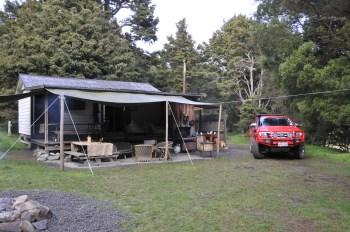Camping is a right of passage for most Kiwis, with most of us having a favourite spot. As owners and keen users of 4WDs we’re in a better position than most to find and/or return to that special spot, or make the most of that favourite overnight tag-a-long or organised back country tour. This month Event Manager Ashley Lucas looks at what’s required to get the most out of one of these tag-a-long trips, and regular contributor Vicki Newport tells us about her favourite spot.
Many of the Safari-type events are over two or three days and involve camping out during the event, and while most safaris are at a new location each night, there are a few that use the ‘cloverleaf’ system and a central or base camp for the duration of the safari.
Whatever system, with some events having 100-120 vehicles a large area is needed for camping and consideration given to those fellow safari goers camped near you. Often the vehicles are in ‘groups’ and the groups tend to camp together as well.
Once you are booked on a safari, you then need to think about your ‘camp’ set. A tent, a sleeping bag, warm clothes, camping chair, fold up table, utensils, plates etc, lighting, drinking water and how you are going to cook, especially if meals are not included or you choose the option of providing your own.
Of course, if you are cooking, some thought needs to go into what food you need to take and how you are going to keep it, and if you want a beer or wine with dinner how you will carry it and keep it chilled. Also afterwards, some consideration needs to go into how you will clean up and do the dishes.
If you plan on having a drink over dinner at camp, consider that glass is easily broken and doesn’t travel well, especially bouncing around off road. Cans are a better option and can be squashed flat therefore taking up less rubbish space.
All items to consider and then finally how you are going to pack it all into your vehicle, along with yourself and the recovery equipment. Often when you see people setting up camp after a day on the tracks you wonder how they managed to bring so much with them and still have room in the vehicle.
It is all down to experience from practise at home beforehand and from previous trips as we learn what we need and what we don’t need. No matter what type of tent you have it pays to check everything at home and ensure everything is there, especially if it has been packed away over winter months.
The weather is another reason to practice knowing where everything goes if you have to set up or break camp in the wind or rain. Trying to get a tent up in the rain or wind is no fun, especially if you are not sure what goes where.
The most common type of tent used these days is the dome type, as they are compact and easy to erect. Rooftop tents are also starting to take hold here with prices more affordable and they allow more space in the vehicle and some fold out in such a way that they also provide a shelter awning as well.
With some of the central base, camp-type events, camper trailers, caravans and even motorhomes can be seen in the campground as people opt for more home comforts. But do check with organisers if access is available for caravans, etc, and that they have the space available.
To add a little spice, the 2013 Hereworth Safari had a competition for the best presented and decorated campsite.
Of the safari events coming up so far for 2014/2015 season, the Ahuroa Fire Brigade, DDORC Farm Tour, Hereworth and Hokianga events are using the central base camp while the Motu East Coast 4WD Safari and the Rangitikei Hunt 4WD Trek events will be traveling to a different location each night.
Whatever the type of event, one of the enjoyable aspects of these safaris is the camping and socialising with old friends and making new ones around the campsite each night. Sitting under the stars talking about the day’s activities and a few stories from the past as well is a great way to end a good day four-wheeling.




